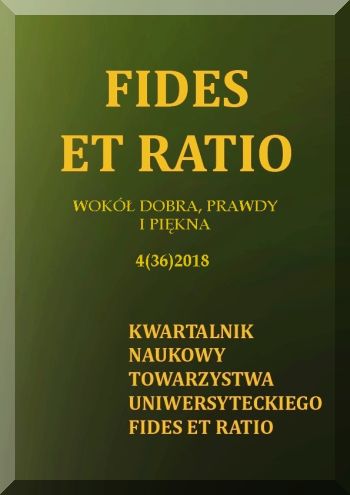Abstract
The hereby study is an attempt to classify different uses of the cross in contemporary visual culture. The first part presents the pagan and Christian symbolism of the cross in historical terms. The second part is dedicated to discussing the examples of non-sacred uses of the cross – mostly those related with war (from the time of Constantine the Great to World War II). The third part is a classification of artistic activities, grouped by the different methods of using the sign of the cross. Works of art are divided into those that utilize only the form of the cross and those which use part of its symbolic meaning (the cross as a tool of torture, the cross as a sign of the Church, the cross as a symbol of religion or of its manifestations, the cross as a timeless brand). Analysing the examples of exploiting the cross in contemporary visual culture in the context of concept and art doctrine, as expressed by the artists themselves, but also confronted with the audience’s reaction to its presence, leads to the conclusion that selectively utilizing the symbol’s rich meanings, fragmenting and deconstructing it, is a road to nowhere. A symbol of complex values functioning in a specific culture cannot be invested with isolated meanings.
References
Altervista, Clet – strada senza uscita, wywiad, http://cristiemadonne.altervista.org/clet-strada-senza-uscita-cristo/ (dostęp 03.01.2019).
Bauman Z. (2011), Kultura w płynnej nowoczesności, Warszawa: Agora SA.
Culture.pl, https://culture.pl/pl/tworca/kosmos-project, (dostęp 03.01.2019).
Ewins N. (2017), Ceramics and globalisation, London-New York: Bloomsbury.
Farina P. (1987), The “Camunnian Rose”, Valcamonica Rock Art., „Tracce” 1997 no 7, opublikowany on-line: http://www.rupestre.net/tracce/?p=1366 (dostęp 03.01.2018).
Farina P. (1998), The motif of the “Camunian Rose”, „Tracce” 1997 no 10, opublikowany on-line: http://www.rupestre.net/tracce/?p=1782 (dostęp 03.01.2018).
Forstner D. (2001), Świat symboliki chrześcijańskiej, Warszawa: PAX.
Giunga A.T. (2012), Giuseppe Veneziano, scandalo al sole – intervista al pittore veneziano, opublikowany on-line: Goleminformazione.it, http://www.goleminformazione.it/articoli/giuseppe-veneziano-terzo-reich-flash-art-milano-biennale-italia-cina.html#.U-0lLfl_v00 (dostęp 03.01.2019).
Goodrick-Clarke N. (2004), The Occult Roots of Nazism: Secret Aryan Cults and Their Influence on Nazi Ideology. New York: Tauris Parke.
Hamann B. (2013), Wiedeń Hitlera. Lata nauki pewnego dyktatora, Poznań: Rebris.
Heartney E. (2006), Sprośna sztuka katolików, „Arteon” 9.
Heartney E. (2004), Andreas Serrano. America and other work, Los Angeles and London: Taschen.
Kobielus S. (1997), Człowiek i gród rajski w kulturze religijnej średniowiecza, Warszawa: PAX.
Kobielus S. (2011), Krzyż Chrystusa, Warszawa: PAX.
Kobielus S. (2013), Concordia novi et veteris testamenti, Zapowiedzi dzieła odkupienia i jego spełnienie w teologii i sztuce średniowiecza, Poznań: Pallottinum.
Koerner B. (2007,) Form, Function and Controversy, „The New York Times” 2007 (8 April), opublikowany on-line: https://www.nytimes. com/2007/04/08/business/yourmoney/08goods. html?_r=0 (dostęp 03.01.2019).
Kopaliński W. (1990), Słownik symboli, Warszawa: Wiedza Powszechna.
Korabiewicz W. (1974), Śladami amuletu, Warszawa: Arkady.
Lindstrom M. (2009), Zakupologia. Prawdy i kłamstwa o tym dlaczego kupujemy, Kraków, Znak.
Mathews G. (2005), Supermarket kultury, Warszawa: PIW.
Nunes A. (2017), The Creator of "Piss Christ" Photographs Trump, Torture, and a Killer Clown, opublikowany on-line: https://www.vice.com/en_us/article/9ag9jz/trump-torture-and-a-killer-clown-inside-provocateur-andres-serranos-latest-exhibition (dostęp 03.01.2019).
Peeters M.A. (2010), Globalizacja zachodniej rewolucji kulturowej. Kluczowe pojęcia i mechanizmy działania, Warszawa: Wydawnictwo Sióstr Loretanek.
Polgovsky Ezcurra M. (2018), Beyond Evil: Politics, Ethics, and Religion in León Ferrari's Illustrated Nunca más, Art Journal, vol. 70, no. 3 (Fall 2018), s. 20-47.
Razz (2014), 5 najbardziej kontrowersyjnych przedstawień Jezusa w sztuce, „WhyArt. Sztuka codziennie” 19 kwietnia 2014 opublikowany on-line: http://whyart.pl/artysci/5-najbardziej-kontrowersyjnych-przedstawien-jezusa-w-sztuce/#more-3399 (dostęp 03.01.2019).
Tancioni E. (2016), Clet Abraham, quando i cartelli stradali prendono vita, https://enricatancioni.com/2016/01/14/clet-quando-i-cartelli-stradali-prendono-vita/ (dostęp 03.01.2019).
Wolak J. (2017), „Milczenie. Pochwała zdrady, opublikowany on-line: https://www.pch24.pl/milczenie--pochwala-zdrady, 49917, i.html (dostęp 03.01.2019).
Wrześniak M. (2018), Pytania o irreligię – czyli gdzie jest granica wykorzystywania symboli sakralnych?, Kwartalnik Naukowy Fides et Ratio”, 1(33), s. 305-318.
Z szafy Madonny, kopertówka z krzyżem http://kobieta.gazeta.pl/follow/1, 153343, 8256609, z-szafy-madonny-kopertowka-z-krzyzem.html (dostęp 03.01.2019).
